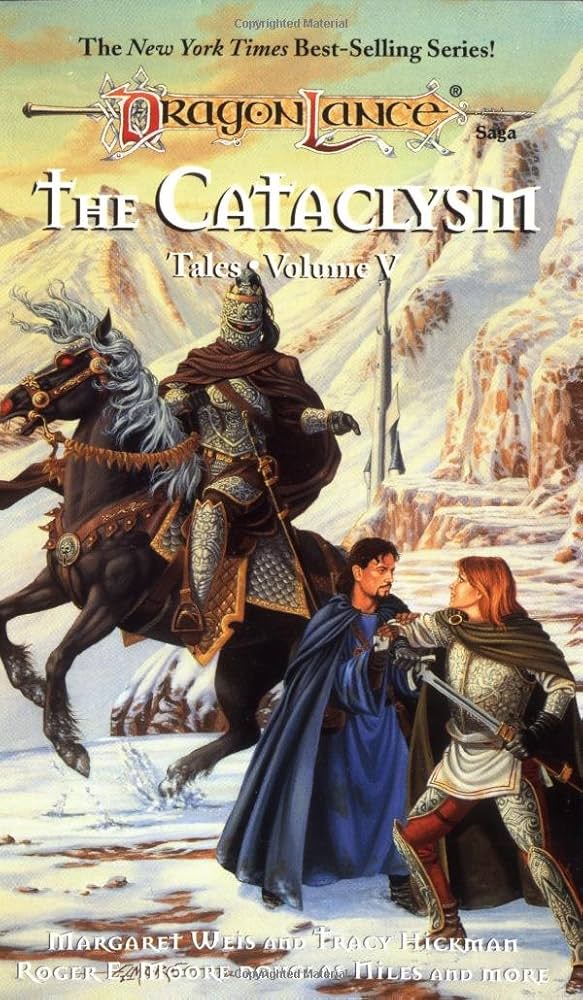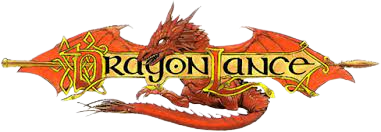The Cataclysm

Table of Contents
ToggleOverview
The Cataclysm is a thematic short story anthology focused on the moment of divine judgment that shattered the continent of Ansalon and ushered in the Age of Darkness. It is a collection of firsthand tales, legends, and personal tragedies set in and around the time the gods cast a fiery mountain down upon Krynn—destroying the Empire of Istar and reshaping the world forever.
This volume takes readers into the terror, confusion, and aftermath of a civilization-ending disaster. It focuses less on sweeping history and more on individual voices—people caught in a storm of divine wrath, political collapse, and moral reckoning.
Historical Context in the Dragonlance Timeline
- Timeframe: 0 AC (the beginning of the Age of Despair)
- What Happened: The Kingpriest of Istar, in his attempt to purge evil from the world, tried to ascend to godhood. The gods responded by hurling a fiery mountain onto Krynn, destroying Istar, sinking entire regions, and causing global cataclysms.
- Why It Matters: The Cataclysm marks the end of the Age of Might and the start of the Age of Despair, a grim period with no gods, no healing, and shattered societies.
Purpose and Structure
This anthology aims to:
- Capture different experiences of the Cataclysm: rich, poor, noble, peasant, religious, magical
- Reflect on guilt, punishment, mercy, and survival
- Give human scale to one of the most mythic events in Dragonlance lore
- Explore the moral ambiguity of divine retribution
It features 10 stories, many of which are tragic, introspective, or mythic in tone.
Notable Stories and Summaries
1. “The Voyage of the Sunchaser” by Paul B. Thompson & Tonya C. Cook
A sea captain and his crew attempt to flee Istar by sailing west—into the unknown—hoping to outrun the gods’ wrath. A tale of desperation, sacrifice, and quiet heroism. Feels like a blend of The Odyssey and The Day After Tomorrow.
2. “The Scroll’s Honor” by Barbara Siegel and Scott Siegel
A priest of Istar receives a divine warning, but struggles to act on it due to politics and fear. A story about faith vs. obedience, and how even small truths are hard to speak in corrupt systems.
3. “The Temple of the Dead” by Nick O’Donohoe
After the Cataclysm, a ruined temple becomes a sanctuary for refugees—and a battleground for hope and despair. A post-Cataclysm tale with an almost post-apocalyptic, survivalist tone.
4. “Colors of Belief” by Dan Parkinson
A sequel or companion piece to his story in The Reign of Istar, this tale focuses on how one man’s art and conviction survive the empire’s destruction. A subtle meditation on how belief evolves after disaster.
5. “The Mountain’s Shadow” by Nancy Varian Berberick
A family living in the shadow of the Temple of Istar watches the sky change. One of the most emotionally powerful stories, this tale captures the intimate moments before the end, and what it’s like to love, fear, and hope right before annihilation.
6. “Into the Light” by Michael Williams
A dreamlike, almost poetic journey of a man who awakens in a devastated landscape and must find meaning in a shattered world. Williams’s lyrical style adds a mythic, spiritual flavor to the anthology.
7. “The Bargain Driver” by Roger E. Moore
One of the more humorous pieces in the collection, involving a traveling merchant who tries to cut deals even during the end of the world. Cynical, sly, and satirical.
8. “A Wayward Son” by Richard A. Knaak
A tale of familial and moral reconciliation just before the Cataclysm strikes. Deeply emotional, focused on a son who returns home to make peace—only to find the world ending around him.
9. “The Last Log of the Jealous Lover” by Margaret Weis & Tracy Hickman
Told through a ship’s log, this story recounts a doomed voyage near Istar as the seas turn to fire and sky. Both eerie and beautiful, it captures the raw force of the Cataclysm through a haunting perspective.
Themes
Divine Judgment and Human Consequence – The anthology explores whether the gods were justified in punishing Istar, and how mortals bear the cost of divine actions.
Pride and Fall – Many stories feature people clinging to their power, position, or illusions as the world collapses, only to be stripped of everything.
Faith After Ruin – How do people rebuild belief after divine wrath? Some find renewal, others abandon all hope.
Survival and Memory – Those who survive the Cataclysm become witnesses and stewards of a broken world. These stories reflect on what is worth saving.
Love in the Face of Despair – Whether romantic, familial, or platonic, many stories focus on clinging to love as the only meaning left in a crumbling world.
Tone & Style
This is one of the darkest and most poetic entries in the Tales series:
- Stories range from intimate character portraits to grand, mythic set pieces
- The mood is often melancholic, suspenseful, and fatalistic
- Several stories use non-traditional formats (logs, dreams, visions) to reflect the surreal nature of apocalypse
Reception
The Cataclysm is widely praised by fans and critics for:
- Giving emotional weight and moral texture to a world-defining event
- Balancing different tones and perspectives—not just high priests or kings, but farmers, sailors, and artists
- Capturing the awe, horror, and sadness of the Cataclysm
It’s considered essential reading for anyone interested in:
- The fall of Istar
- The beginning of the Age of Despair
- The theological and emotional impact of divine silence in Dragonlance
Final Thoughts
The Cataclysm is a powerful, tragic, and deeply human collection that explores how people respond when the sky falls—literally and spiritually. Whether through a sailor’s last prayer, a priest’s final confession, or an artist’s final stroke of color, the anthology captures the soul of a world ending, and the seeds of what may rise from the ashes.
Perfect for:
- Fans who want to understand the emotional and historical depth of Dragonlance lore
- Readers who enjoy disaster stories, religious themes, and tragic heroism
- Anyone curious about how a fantasy world endures its darkest hour
